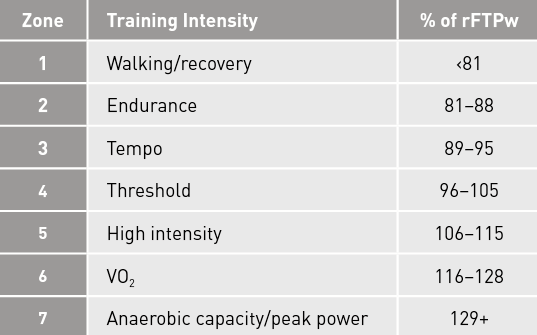If you are struggling with an Achilles’ tendon pain our coaches have put together the top things you can do to prevent further pain and or relapse to getting healthy again. Please read our “injured” article” in addition to this specific injury before resuming training.
★★★Step back weeks
A step back week in training is one where the total training load backs off in order to recover and rest from the previous week(s) build up. This is an essential week towards absorbing training to help set the stage for future work. Without proper rest, true build work can be halted and your potential not reached.
★★★ Training Peaks Connect IQ App
★★★ Traveling and training
Whether you are traveling for work or play, we know that “life” is going to get in the way of the perfect training plan. Its not easy to fit everything in and nor should you try to. Being flexible and adaptable to the week when you are in transit can mean maintaining your fitness and growing in a healthy way. Our coaches have put together these key points and guidelines for you to stay on task and on track!
★★★ Swimming cadence
★★★ Back health and strength
As Tristar Athletes at times we undervalue the work our backs do for us daily. The back is in fact “central” to everything we do. How to keep your back in good health comes down to multiple factors as we explain in our coaches corner how to prevent injury, overcome tightness, pain, and how to build and maintain a strong back.
★★★ Running cadence
★★★ D.Y.O.T ⚠️ "Doing your own thing"
★★★ Bike cadence for triathletes
★★★ Heal drop for running
★★★How to adjust your weekly schedule when "life happens" using swing days
★★★Tristar Athletes raceday nutrition fueling guidelines
★★★ Rest & Recovery Days ⛔️
★★★ Ⓦ Running power FTP power defined (rFTPw)
Testing your power in running periodically is important to you training and training zones working with your Tristar Coach. While power in running varies less so than cycling power, keeping an accurate rFTPw (or threshold power. r = “running” and Pw = power. rFTPw) is important towards determining your total load and intensity of your program.
rFTPw NOTES and best practices
One of the major advantages to running with power is that we can clearly define your intensity.
rFTPw is a strong indicator of your race potential and overall potential.
it is the metric used to calculate all intensity in your Tristar plan and program.
All of your run power zones are calculated off this single number.
Do you need to test all the time? No, you can use running data from races and or training to support your rFTPw.
if you switch from one run powermeter manufacturer to another recognize your rFTPw will be different and then you would want to retest.
Tristar testing sets for power; We use two power tests, one which is shorter call the “3/9” TEST, and a “30min run TT (Time Trial)”. The 3/9 test is shorter and does not require as much recovery however the accuracy for the 30min run TT may be better depending on your ability to pace. Your coach will key you in to which test is best for you, your goals and plan. Note; during your testing you will also find your rFTPa (r = run, F = Functional, T = Threshold, Pa = pace) which is helpful when learning how to run at a goal speed or effort beyond power. You will have both FTP’s set in training peaks.
Races: races 5K-13.1mi road races can help determine your rFTPw depending on your ability and time it takes to do each race distance. Example, slower athletes may use 10K as their rFTPw proxy.
Run rFTPw changes regularly. When you stop training threshold power in running will drop, with extended detraining lowering your rFTPw will be critical. Conversely, when you are training a lot at just below or just above run threshold power you may need to update and increase your rFTPw.
What happens if you don’t have an accurate rFTPw? …When set too low this can overstate your actual fitness and your gains may not be as great as they could be in training. … when set too high this can underestimate the total training load and you can get sick or injured.
★★★ Running with power vs biking with power
For those Tristar Athletes familiar with bike power zones we have presented the main similarities and differences below to running with power and biking with power.
Similarities
Both use FTP (functional threshold power)
Both have their own unique % of FTP that the zones are made up of.
Both have an absolute advantage for training, a watt is a watt. A measurable output.
Both are helpful for targeting races and for yearly planning.
Both can be used to pace more accurately than heart rate, pace or perceived effort alone.
Both need to be calibrated regularly and the FTP (hour of power or threshold) updated regularly to ensure accuracy.
Run and Bike power zones side by side
Comparison to rate of perceived effort.
Differences
Run power is a more complex measurement as it has two power outputs measure; form power and horizontal or “power that moves you forwards.”
This extra power data can help with form and speed. (Form is crucial to run economy and speed.)
Lower power zones for running tend to be higher as a % of FTP compared to cycling. For example 85% for run power is middle of zone two where as for cycling this is the middle of zone 3.
More power does NOT mean you will necessarily run faster….more power in cycling generally does. Running with greater form (or lowering form power) and increasing stiffness equates to running faster.
Due to the above; We must be observant of both horizontal and form power at all times. As an athlete you should not blindly train by power or zones but rather zones + form efficiency.
The goal should be to maximize your speed/watt.
New to power? Start by focusing on being efficient at slower powers and paces before moving on to harder efforts and work.
With run power you should chart/track your baseline efficiency numbers for each race pace effort you are trying to accomplish. Example; perhaps you have a form limiter when you are running slower? (know your EI, or efficiency index) If you are training for a slower marathon or Ironman marathon for example and your form power is high at slower efforts vs faster there is run form work to be done there. That form work should come before training at a specific wattage or power zone.
running power zones (Jim Vance) vs bike power zones (ALLen and cogan).


★★★Running with Power: Leg stiffness
When Tristar athletes are running rarely do they think about their legs as “stiff” or as “springs” that recoil and return energy. Much of the time we think about how hard we are running or perhaps our form but one area that can help to improve your running speed is the idea that how well you will ever run is based on “leg spring stiffness or “LSS”.
★★★ MAF Training - the hows the why's and the calculations
1. Subtract your age from 180.
2. Modify this number by selecting among the following categories the one that best matches your fitness and health profile:
a. If you have or are recovering from a major illness (heart disease, any operation or hospital stay, etc.) or are on any regular medication, subtract an additional 10.
b. If you are injured, have regressed in training or competition, get more than two colds or bouts of flu per year, have allergies or asthma, or if you have been inconsistent or are just getting back into training, subtract an additional 5.
c. If you have been training consistently (at least four times weekly) for up to two years without any of the problems just mentioned, keep the number (180–age) the same.
d. If you have been training for more than two years without any of the problems listed above, and have made progress in competition without injury, add 5.
For example, if you are thirty years old and fit into category (b), you get the following:
180–30=150. Then 150–5=145 beats per minute (bpm).
In this example, 145 will be the highest heart rate for all training. This is highly aerobic, allowing you to most efficiently build an aerobic base. Training above this heart rate rapidly incorporates anaerobic function, exemplified by a shift to burning more sugar and less fat for fuel.
★★★ Running Ⓦ Power meter and your training: The intro to the tristar methods
★★★Mentorship Team LIVE call: Tristar Athletes Top 10 mistakes made in the off season
No need to reinvent the wheel this winter.. instead ride it! Coach Cliff Scherb
Not building up the base enough and jumping into too much intensity.
Trying to build FTP (functional threshold pace and or power) while losing weight. These are mutually exclusive concepts!
Increasing run volume and intensity too quickly in the off season to “work the run”.
Not making time for gym and stretching to rebuild from the previous season.
Consuming too many fat calories vs needed carbohydrate energy. (Active athletes need to limit total fat calories as fat calories are 9 calories per gram)
Not keeping at least one swim per week. If you are a triathlete you should do at least one workout per sport per week. Less than this can erode previous training you have done for thresholds.
Not resting enough and planning down weeks.
Going too long, running especially and biking somewhat as well.
Not working your weaknesses but instead working your strengths, “what your good at”.
Failure to advance your mechanical skills in swimming, biking and running.





